AKA Peace: Off Target
The 2012 exhibition AKA Peace was a primary example of the limitations of much of the so-called “political art” in our current period. Curated by U.K. artist Jake Chapman, the show was held at The Institute of Contemporary Arts in London, England, from Sept. 25 to Sept. 30, 2012. The intent of the exhibit was to give decommissioned AK-47 rifles to 23 different artists, who would then transform the rifles into sculptural icons for peace. The melodramatic premise of the show was akin to the antiwar bumper sticker slogan “War is not the answer,” but what were the questions posed by the exhibition?

Curator Jake Chapman works together with his brother Dinos under the moniker of the Chapman Brothers; the duo have become superstars in the postmodern art world through attention grabbing works mostly known for banality and shock value.
As a for instance, in 2003 the brothers purchased a pristine edition of Francisco Goya’s famous antiwar print suite, Disasters of War, and defaced the etchings by drawing clown and puppy heads on Goya’s characters. Renamed Insult to Injury, the Chapmans exhibited the mutilated etchings at the U.K.’s Tate Modern. Evidently, these days trashing a suite of the most famous antiwar prints ever created qualifies one to curate an “antiwar” art exhibition.
In the official video for AKA Peace, the AK-47 was referred to as “the greatest killing machine in the world.” That preposterous statement means the rifle created by Soviet weapons designer Mikhail Kalashnikov in 1947 (the Avtomat Kalashnikova model 1947) is deadlier than today’s modern cluster bomb munitions, the Apache Attack Helicopter, the AC-130 gunship, the B-2 Stealth bomber, and the nuclear powered Nimitz Class Aircraft Carrier, not to mention the atomic bomb arsenals of the world. The ridiculous assertion from the organizers of AKA Peace set the stage for an exhibit that was long on sensationalism but lacking any political insight or grasp of history.
AKA Peace was sponsored and partly organized by Phillips de Pury & Company, a multi-million dollar auctioneer and art dealership specializing in postmodern art. In May of 2012 the London-based auction house sold a 1981 painting of a black Christ-like figure by Jean-Michel Basquiat for $16.3 million. On Nov. 10 2012, the auction house teamed up with Russia’s Hermitage Museum for a “gala” auction of works by postmodern art stars Jeff Koons and Damien Hirst; the Honorary Chairman of the gala’s Host Committee was none other than L.A.’s billionaire philanthropist, Eli Broad. Rather than being an exhibit motivated by actual social and political concerns, AKA Peace instead fell into Phillips de Pury’s model of peddling works from “blue chip” artists to oligarchs with absolutely no taste in art.
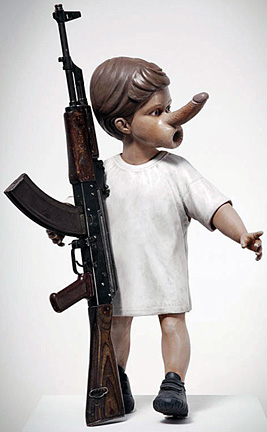
The two collaborative sculptures the Chapman Brothers included in AKA Peace are titled Yin and Yang. They depict life-sized immature boys, barely pubescent, wearing tennis shoes and T-shirts while clutching AK-47s; each boy has a large erect penis for a nose and an extended anus for a mouth. This is not the first statue from the Chapman Brothers that makes one think of pedophilic disorder, but what does this trash have to do with pacifism?
To say these three-dimensional eyesores impart a politically confused point of view is an understatement. The vulgar statuettes are not antiwar in the least, they represent nothing more than overt misandry since Yin and Yang convey the notion that wars occur solely because men and boys are supposedly predisposed to violence. The statues also have the stench of pedophilia.
The sculptures were apparently titled after the ancient Chinese Taoist metaphysical concept relating to the primal duel energies of the universe, the Yin and Yang.
That philosophy denies the existence of absolute good and evil, proffering instead the idea that negative and positive energies are present in all things; light and dark, water and fire, male and female – forces that cannot exist without the other. Assumptions that Yin represents the feminine while Yang denotes the masculine are inaccurate, since each carries within it the essence of the opposite. Quite frankly the Chapman Brother’s sculptures do not fit into the Taoist outlook.
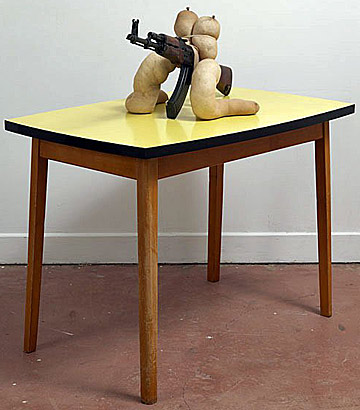
The Chapman’s bungled attempt at describing war as the result of metaphysical forces is a bit of a stretch… even for them. But the work of the Chapman Brothers in AKA Peace was only the starting point of a muddleheaded exhibit.
Equally confused was the work of Sarah Lucas. Her sculpture titled Yes depicts a grotesquery that is faintly and horrifically reminiscent of the human form. Sans arms, and with two apparent breasts bound together with rope serving as a head, the heap sits on a table with its feetless legs spread akimbo; an AK-47 between its legs stands in for the meat lump’s enormous erect penis. Lucas seems to be saying that testosterone is responsible for armed conflict, a theme that runs throughout AKA Peace.
Not to be outdone in the ludicrous department is the artwork by Laila Shawa’s, Where Souls Dwell. In an interview with ITN News in the U.K., Ms. Shawa told a hair-raising yarn regarding the creation of her AK-47 sculpture; she asserted that “while cleaning the gun in order to start working on it, I went into the barrel of the gun and I found congealed blood.”
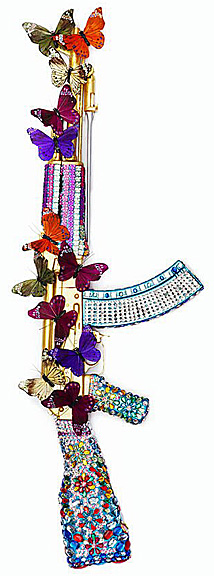
To someone unfamiliar with firearms, Shawa’s testimonial is chilling. However, the odds of congealed human blood being found in the barrel of a battle rifle, even one from a combat zone, are astronomical. If you doubt me just ask any Afghan or Iraq War veteran, there should be a number of them in your neighborhood.
Ms. Shawa no doubt found gelatinous cosmoline in the barrel of her decommissioned AK-47. Since World War II cosmoline has been used by armies to protect and preserve firearms placed in storage; the brown-colored viscous fluid could be mistaken for “congealed blood” by the uninformed.
It is a certainty the AK-47’s used in the exhibit had at one time been dipped in cosmoline and placed in storage before eventually being acquired by the organizers of the AKA Peace exhibition.
Spin AK47 for Peace One Day by Damien Hirst is modeled after his series of “spin paintings,” works that are made by pouring paint onto canvas or paper secured to a spinning platform. The process has long been utilized in kindergarten and grade school craft projects to help familiarize children with art and painting, causing art critic Robert Hughes to deplore Hirst’s spin paintings as nothing more than “enlarged versions of the pseudo-art made in funfairs.”
Of course the only thing that differentiates Hirst’s spin paintings from those made by children at a carnival or kindergarten, is his ability to sell the stupid things for upwards of £1m ($1,603,810).
How a paint-splattered AK-47 conveys meaningful insights into wars and why we fight them escapes me. Hirst is the richest artist in the world with a net worth of well over $450 million, but his Spin AK47 for Peace One Day is only further proof that he produces nothing but empty vacuities.
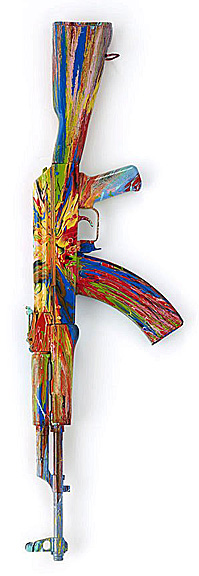
Bran Symondson’s Commodities comes closest to making a connection between economics and war, but the work is problematic for a number of reasons. A London-based photographer, Symondson served in Afghanistan after joining the British Army.
He returned to Afghanistan to document the war as a photographer. Symondson conceptualized the AKA Peace exhibit after seeing the U.S. trained and organized Afghan National Police decorating their AK-47 rifles with “colorful stickers, roses, or glitter tape”.
Once back in London he promoted the idea of an exhibit that would transform the AK-47 rifle, “the most devastating weapon in the world,” into a “powerful catalyst for hope and peace.” Symondson pasted U.S. dollar bills all over his AK-47, attaching a flower made from U.S. dollars to the rifle’s bayonet. Commodities seems an obvious statement, but a closer examination only brings perplexity.
Great Britain’s military involvement with Afghanistan did not begin when it joined the United States in invading and occupying the country in 2001. Britain had previously marched into Afghanistan in campaigns to become the dominant power in the region during the so-called “Anglo-Afghan wars” of 1839-1842, 1878-1880, and 1919.
Tens of thousands of Afghans died in those colonial wars of occupation, but ultimately Afghan resistance forced the British Empire to withdraw from the country that became known as the “graveyard of empires.” The AK-47 rifle was not involved in any of those military battles, because the Soviet rifle had not yet been invented.
The influx of Soviet weapons into Afghanistan began in 1978 with the overthrow of the Afghan king and the establishment of the pro-Soviet “Democratic Republic of Afghanistan.” Infighting among government factions led to purges and assassinations, while Islamist groups began an armed uprising against the new regime.
According to the former head of the CIA, Robert Gates, on July 3, 1979 President Jimmy Carter signed a directive giving covert aid to the Islamists fighting the Afghan regime [1]. Ultimately the Soviet Union made the mistake of invading the “graveyard of empires” on Dec. 27, 1979, unleashing an occupation that would last until Feb. 15, 1989. While the Soviets armed and trained their puppets in Kabul, the U.S. and Britain armed and trained the “Afghan Freedom Fighters,” Islamic extremists who the U.S. armed with billions of dollars worth of weaponry, including thousands of advanced surface-to-air Stinger missiles. Of course, the artists involved in the AKA Peace exhibit don’t mention any of this… they can only wring their hands over those scary looking AK-47s.

And why the focus on the AK-47 rifle to begin with? How can an aversion to a single weapon, the Kalashnikov rifle, be equated to a morally principled stance regarding opposition to war?
Over the decades the AK has been utilized by dictatorial states, as well as those revolutionaries seeking to overthrow them, so the question is not the Kalashnikov, but the use of violence to effect change. It all makes me think of the American Civil War; how would slavery for 3 million people in bondage have ended without the force of arms?
One could say the American Civil War was the first modern war, in that many of the arms used were the result of mass production and technological innovations. For its day, the Springfield Model 1861 could have been called “the most devastating weapon in the world”. Weighing 9 pounds and firing a massive .58 caliber round, it was certainly a devastating rifle. But was the Springfield “evil” by virtue of it being a firearm? Northern soldiers, including former slaves, shouldered the Springfield rifle in the Union Army in order to put an end to the system of slavery, were they wrong to do so?
Though I deeply respect pacifism as a philosophy, I am not committed to it myself, and I do not believe the organizers of AKA Peace truly have faith in it either. In an interview with GQ regarding the exhibit, Bran Symondson disclosed that Sir Winston Churchill is one of his biggest heroes. That is an odd choice of champions for an “antiwar” activist. Churchill once declared: “If you will not fight for right when you can easily win without blood shed; if you will not fight when your victory is sure and not too costly; you may come to the moment when you will have to fight with all the odds against you and only a precarious chance of survival. There may even be a worse case. You may have to fight when there is no hope of victory, because it is better to perish than to live as slaves.”
Given that AKA Peace was organized by British artists, it might have focused on Britain’s Guided Multiple Launch Rocket System (GMLRS), now deployed by Her Majesty’s Royal Artillery in Afghanistan. The artillery piece fires twelve 200 pound high explosive rockets guided by a global positioning system. I hear the tremendously effective rockets rarely miss their intended targets – collateral damage not withstanding. AKA Peace artists might also have enjoyed decorating a few dozen L118 “Dragon” Light Guns, the 105mm artillery piece Her Majesty’s Royal Artillery uses to pulverize whoever it might be walking around at the limits of the gun’s effective range of 10 miles.
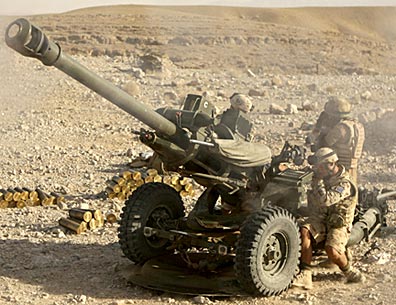
I am certain the Taliban would happily trade in thousands of their old battle-worn AK-47 rifles for a few modern British GMLRS and Dragon artillery pieces… so, which is the more “devastating weapon in the world”?
Granted, the Dragon artillery piece does not provide much of a canvas in terms of areas to affix dollar bills, paste jewelry, or splattered paint, but that is the challenge of being an artist. Imagine if the Chapman Brothers could have given a Dragon artillery piece their Yin and Yang treatment. Talk about a phallic symbol!
AKA Peace was not an antiwar exhibit; it ignored history and kept clear of any critique of ultra-nationalism, militarism, or imperialism. It did not critically assess the economic and political reasons that give rise to war. It had nothing to say about fundamentalist religious extremism, nor did it even present an elemental pacifist stance regarding warfare. The exhibit depoliticized war, the most political of all issues. It was not a loathing of state violence that served as the foundational view of the show so much as it was an irrational and morbid fear of firearms. AKA Peace was one of the most simplistic responses I have seen from artists reacting to real world political issues.
It was a huge and unforgivable failing that the artists and organizers of AKA Peace chose to demonize a particular rifle, the AK-47, while evading the policies and geo-political interests that have turned Afghanistan into a killing field.
There are many delicious ironies about our present world situation that AKA Peace managed to miss, and that is no small matter for a crowd of artists beholden to the irony-obsessed school of postmodernism. If looking for irony, one could toss the entire exhibit in the rubbish bin and focus on the words of Yevgeny Y. Satanovsky, the president of the Institute of the Middle East in Moscow. Quoted in a New York Times article regarding Russian opinion of U.S. policy in the Middle East, in particular their view of the Islamic terror attack on the U.S. consulate in Benghazi, Libya that took place on Sept. 11, 2012, Mr. Satanovsky said:
“You are the Soviet Union now, guys, and you pay the price. You are trying to distribute democracy the way we tried to distribute socialism. You do it the Western way. They hate both. They lynched Qaddafi – do you really think they will be thankful to you? They use stupid white people from a big rich and stupid country which they really hate.”
I invite the group of participating artists in the AKA Peace exhibit to mull over Satanovsky’s words.
####
UPDATE 12/24/2013: Mikhail Kalashnikov died in Izhevsk, Russia on December 23, 2013 at the age of 94.
####
[1] “From the Shadows”. Written by Robert M. Gates, former head of the C.I.A. under President George H.W. Bush, and also former Secretary of Defense under President Obama.

